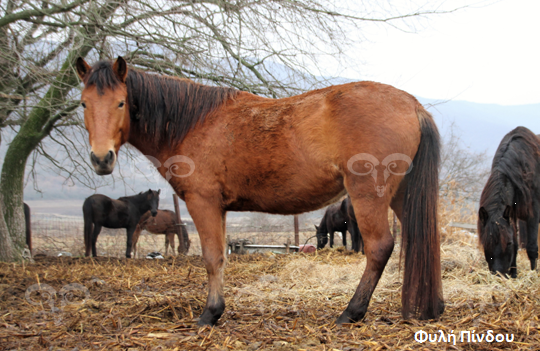History
The breed of Pindos is the unsung hero of Greek breeds. It received its name from the mountain range of Pindos and is the most representative breed of the mountain type. The Pindos breed has lived and developed in the Greek domain for thousands of years and is extremely well adjusted to the harsh-mountainous geoclimatic conditions of the country.
The humble but exceptional characteristics of the breed rendered the horse of Pindos an invaluable servant for the Greek agricultural community. The Pindos breed is chiefly bred in the mountainous or semi-mountainous regions of Epirus, Thessaly and Macedonia; nevertheless, it can be found all over Greece, in both mainland and insular regions. In the past its services were irreplaceable in tasks as logging, nomadic-extensive livestock breeding and agriculture.
During World War II it played an important role in the Greco-Italian war and the National Resistance, carrying ammunition to the Pindos front and other mountainous areas.
The breed is inextricably linked to nomadic-extensive livestock breeding and has contributed significantly to the daily life of the inhabitants of mountainous and remote areas. Post-war, despite the abandonment of rural areas, the mechanization of agriculture and transportation and the decline of extensive livestock breeding, it has continued to be used by nomadic livestock breeders and loggers in areas where motor vehicles have no access.
The Pindos horse is calm, reliable and easy to train. It is frugal, adapted to surviving and performing on very small rations. It has great stamina and a very steady footing on difficult and rocky trails.
Morphological Traits
The height of the Pindos horse is 120-140 cm at the withers. The head is slender and expressive. The mane is thick and the tail is long. The body is relatively narrow, the neck and the buttocks are strong. The dorsal line is straight. Lastly, most Pindos horses are cow-hocked, a characteristic of all mountain breeds.
The main colours are bay, grey and chestnut. The hooves are dark, narrow and very hard.
Use
Extremely well adapted to difficult work conditions, this horse has the ideal build to move on rocky ground. It has very strong limbs, joints and bones, as it has been bred for thousands of years in the mountains of Greece. The Pindos horse continues to be useful, as it always was, in mountainous and not easily accessible areas. It is used for transporting cargo, for light agricultural tasks as well as for horse riding in agrotourism facilities.
Population
cording to data from the Center of Animal Genetic Resources (2019), the total population is 5,400 horses registered in the studbook (3,555 females and 1,225 males).
It is worth noting that the number of animals that meet all the characteristics of the breed is smaller as it is difficult to identify crossbred animals. The population of the breed falls in the‘Minority’ cluster.




